Related Research Articles

Union Pacific Railway Engine No. 737 or UP 737 is a 4-4-0 "American" type steam locomotive. It is currently the oldest preserved Union Pacific steam locomotive. It was originally acquired by the Union Pacific Railroad (UP) in 1887.
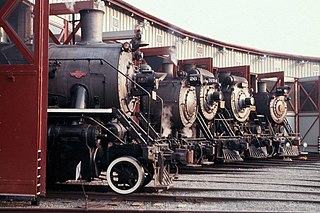
Steamtown National Historic Site (NHS) is a railroad museum and heritage railroad located on 62.48 acres (25.3 ha) in downtown Scranton, Pennsylvania, at the site of the former Scranton yards of the Delaware, Lackawanna and Western Railroad (DL&W). The museum is built around a working turntable and a roundhouse that are largely replications of the original DL&W facilities; the roundhouse, for example, was reconstructed from remnants of a 1932 structure. The site also features several original outbuildings dated between 1899 and 1902. All the buildings on the site are listed with the National Register of Historic Places as part of the Delaware, Lackawanna and Western Railroad Yard-Dickson Manufacturing Co. Site.
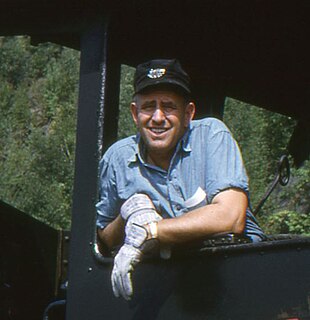
Francis Nelson Blount was president and founder of Blount Seafood Corporation and the founder of Steamtown, USA, the Monadnock, Steamtown & Northern Railroad, and the Green Mountain Railroad. A millionaire and a railroad enthusiast, Blount's collection of vintage steam locomotives and rail cars —— originally based in New England —— was one of the largest ever assembled and still remains the cornerstone of the modern-day Steamtown National Historic Site.

The GE 44-ton switcher is a 4-axle diesel-electric locomotive built by General Electric between 1940 and 1956. It was designed for industrial and light switching duties, often replacing steam locomotives that had previously been assigned these chores. This locomotive's specific 44-short ton weight was directly related to one of the efficiencies the new diesel locomotives offered compared to their steam counterparts: reduced labor intensity. In the 1940s, the steam to diesel transition was in its infancy in North America, and railroad unions were trying to protect the locomotive fireman jobs that were redundant with diesel units. One measure taken to this end was the 1937 so-called "90,000 Pound Rule" : a stipulation that locomotives weighing 90,000 pounds (41,000 kg) – 45 short tons – or more required a fireman in addition to an engineer on common carrier railroads. Industrial and military railroads had no such stipulation. The 44-ton locomotive was born to skirt this requirement. Other manufacturers also built 44-ton switchers of center-cab configuration. 276 examples of this locomotive were built for U. S. railroads and industrial concerns, four were exported to Australia in 1944, 10 were exported to Canada, 10 were exported to Cuba, one was exported to the Dominican Republic, five were exported to France, three were exported to India, six were exported to Mexico, five were exported to Saudi Arabia, one was exported to Sweden, two were exported to Trinidad, 10 were exported to Uruguay, and 57 were built for the U. S. Military. Many remain, in service and in museums.

The Strasburg Rail Road is the oldest continuously operating railroad in the western hemisphere and the oldest public utility in the Commonwealth of Pennsylvania. Chartered in 1832, the Strasburg Rail Road Company is today a heritage railroad offering excursion trains hauled by steam locomotives and rarely diesel locomotives on 4.5 mi (7.2 km) of track in Pennsylvania Dutch Country, as well as providing freight service to area shippers. The railroad's headquarters are outside Strasburg, Pennsylvania.

Spokane, Portland & Seattle 700 is the oldest and only surviving example of the class "E-1" 4-8-4 "Northern" type steam locomotive and the only surviving original Spokane, Portland and Seattle steam locomotive. It was built by the Baldwin Locomotive Works in May 1938. Nearly identical to the class "A-3" Northerns built for Northern Pacific Railway, it burns oil instead of coal.

Strasburg Rail Road No. 90 is a 2-10-0 "Decapod" type steam locomotive owned and operated by the Strasburg Rail Road outside of Strasburg, Pennsylvania. Built by the Baldwin Locomotive Works in 1924, No. 90 originally pulled sugar beet trains for the Great Western Railway of Colorado. In 1967, No. 90 was sold to the Strasburg Rail Road where it now resides and operates today for use on excursion trains. Today, No. 90 is one of only two operational Decapod type steam locomotives in America, the other being Frisco No. 1630 at the Illinois Railway Museum in Union, Illinois.

The Ohio Central Railroad System is a network of ten short line railroads operating in Ohio and western Pennsylvania. It is owned by Genesee & Wyoming Inc.

Canadian Pacific 2816, also known as the "Empress", is a preserved class "H1b" 4-6-4 "Hudson" type steam locomotive built by the Montreal Locomotive Works (MLW) in December 1930 for the Canadian Pacific Railway (CPR); the only non-streamlined H1 Hudson to have survived into preservation.

Pennsylvania Railroad No. 1223 is a class "D16sb" 4-4-0 "American" type steam locomotive built in November 1905 for the Pennsylvania Railroad by their own Altoona Works for passenger service. After being retired from active service in 1950, the locomotive ran excursion trains on the Strasburg Rail Road outside of Strasburg, Pennsylvania from 1965 to 1989 when it was removed from service requiring firebox repairs. Currently, the locomotive is on static display at the Railroad Museum of Pennsylvania outside of Strasburg. It was listed on the National Register of Historic Places in 1979. No. 1223 is the only surviving example of the Pennsylvania Railroad's D16sb class.

Canadian National 3254 is a class "S-1-b" 2-8-2 "Mikado" type steam locomotive built in 1917 for the Canadian National Railway by the Canadian Locomotive Company as a member of the Canadian National class S-1-b. It used to be a part of the operating fleet at the Steamtown National Historic Site in Scranton, Pennsylvania until being indefinitely retired from excursion service in 2012 due to serious frame issues, being replaced by Boston and Maine 4-6-2 #3713 as part of Steamtown's operating fleet for use on excursion trains.
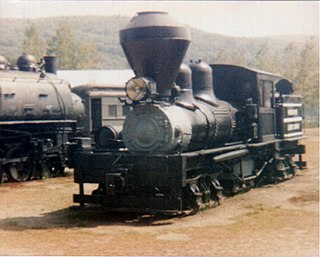
Steamtown, U.S.A., was a steam locomotive museum that ran steam excursions out of North Walpole, New Hampshire, and Bellows Falls, Vermont, from the 1960s to 1983. The museum was founded by millionaire seafood industrialist F. Nelson Blount. The non-profit Steamtown Foundation took over operations following his death in 1967. Because of Vermont's air quality regulations restricting steam excursions, declining visitor attendance, and disputes over the use of track, some pieces of the collection were relocated to Scranton, Pennsylvania in the mid-1980s and the rest were auctioned off. After the move, Steamtown continued to operate in Scranton but failed to attract the expected 200,000–400,000 visitors. Within two years the tourist attraction was facing bankruptcy, and more pieces of the collection were sold to pay off debt.

The Gettysburg Railroad was a short-line railroad that operated in Pennsylvania from 1976 to 1996. The 23.4 mi (37.7 km) line ran from Gettysburg to Mount Holly Springs.

Canadian Pacific Railway No. 1293 is a class "G5d" 4-6-2 "Pacific" type steam locomotive built in June 1948 by the Canadian Locomotive Company for the Canadian Pacific Railway. Built for passenger service, the 1293 served an eight-year career until being replaced by diesel locomotives where it was then retired in 1959. Purchased in 1964 by F. Nelson Blount for use at his Steamtown site in Bellows Falls, Vermont, the 1293 was easily restored to operation for hauling fan trips for the general public. The 1293 was later sold to the Ohio Central Railroad in 1996 for tourist train service. Today, the locomotive is out of service at the Age of Steam Roundhouse in Sugarcreek, Ohio.
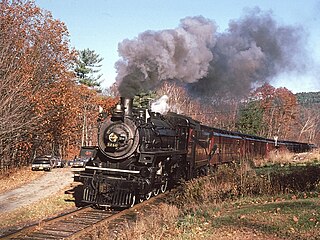
Canadian Pacific Railway No. 1246 was one of three 1200-series Canadian Pacific Railway locomotives in the Steamtown, U.S.A. collection. Like CP 1293 and CP 1278, this locomotive was one of the operational engines at Steamtown. When Steamtown left its Bellows Falls, Vermont location in the fall of 1983, the engine led the "farewell to Vermont" excursions. There were two such 100-mile (160 km) excursions "through a landscape of covered bridges, rushing streams and scenic countryside". The train had the capacity of 800–1000 passengers. Built in 1946, CPR 1246 is a 4-6-2 type, class G5c locomotive. In June 1967, Canadian Pacific 1246 was sold to the Green Mountain Railroad and relettered to GMRy 1246. It remained under Green Mountain ownership until was sold back to Steamtown six years later in July 1973 and relettered back in its Canadian Pacific lettering.

Nickel Plate Road 759 is a class "S-2" 2-8-4 "Berkshire" type steam locomotive built in 1944 by the Lima Locomotive Works in Lima, Ohio as a member of the S-2 class for the New York, Chicago & St. Louis Railroad, commonly referred to as the "Nickel Plate Road". Built as a fast freight locomotive, No. 759 served the Nickel Plate until being retired in 1959 and placed into storage. In 1965, No. 759 was purchased by F. Nelson Blount for display in his Steamtown, U.S.A. collection in North Walpole, New Hampshire. The locomotive was restored to operating condition in 1967 by New York commodity broker Ross Rowland for use in hauling his Golden Spike Centennial Limited, a special commemorative train that celebrated the 100th anniversary of the completion of the Transcontinental Railroad in 1969. Afterwards, No. 759 pulled numerous excursions for Ross Rowland and Steamtown until being retired once more and placed back on display in 1977. Today, the locomotive remains on static display at the Steamtown National Historic Site in Scranton, Pennsylvania. As of 2019, sister engine No. 765 continues to operate in mainline excursion service.
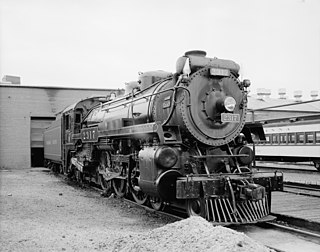
Canadian Pacific 2317 is a class "G-3c" 4-6-2 "Pacific" type steam locomotive built in June 1923 by the Montreal Locomotive Works for the Canadian Pacific Railway. As a member of the G-3 Class, the 2317 was in use in fast passenger service until being retired in 1959 after having its duties taken over by diesel locomotives. The locomotive was placed in storage until 1965 when it was purchased for display in the Steamtown, U.S.A. collection in Bellows Falls, Vermont. In 1978, the locomotive was restored to operating condition for the purpose of pulling excursion trains for Steamtown until it was taken out of service in 2010. No. 2317 was currently stored, awaiting for a future overhaul.

The Reading T-1 is a class of 4-8-4 "Northern" type steam locomotives owned by the Reading Company. They were rebuilt from 30 "I-10sa" class 2-8-0 "Consolidation" type locomotives between 1945 and 1947. Out of the 30 rebuilt, 4 survive in preservation today, those being numbers 2100, 2101, 2102 and 2124.

Reading 2102 is a preserved American class "T-1" 4-8-4 "Northern" type steam locomotive constructed in 1945 for use by the Reading Company as a member of the T-1 class. Constructed from an earlier 2-8-0 "Consolidation" type locomotive built in 1923, No. 2102 handled heavy coal train traffic for the Reading until being retired from revenue service in 1956. Between 1962 and 1964, No. 2102 was used to pull the famed Iron Horse Rambles excursions alongside sister engines 2100 and 2124. After the rambles ended in 1964, No. 2102 was sold to Steam Tours of Akron, Ohio, to spend the next 23 years pulling various fan trips in the Northeast, Mid-Atlantic and Midwest. In 1985, it was sold again to Andy Muller to operate on his Reading Blue Mountain and Northern Railroad. It would operate on the regional railroad alongside 4-6-2 "Pacific" No. 425 until its flue ticket expired in 1991. Restoration work to bring the locomotive back to service began in February, 2016 and will likely be completed by July, 2021.
Lake Superior and Ishpeming Railroad No. 33 is a preserved SC-1 class 2-8-0 "consolidation" type steam locomotive originally built by the Baldwin Locomotive Works in April 1916 for the Munising, Marquette and Southeastern Railway as No. 44. In 1924, the MM&SE was purchased by the Lake Superior and Ishpeming Railroad and the locomotive was renumbered to 33. It served the LS&I by pulling heavy iron ore trains until it was retired from revenue service in 1962. The following year, it was sold to the Marquette and Huron Mountain tourist railroad to operate in excursion service, but instead sat idle in Marquette. In 1965, No. 33 was purchased by the founders of the Hocking Valley Scenic Railway in Ohio. Rebuilt to operating condition, No. 33 ran on the HVSR for many years before being sidelined in 1996 for an FRA-required overhaul that couldn't be accomplished. In 2003, No. 33 was traded to the Ohio Central Railroad and was overhauled for some occasional excursion runs between 2005 and 2008. The locomotive briefly operated again around the Age of Steam Roundhouse between 2018 and 2020. As of 2021, No. 33 is sidelined, awaiting for extensive firebox repairs.
References
- ↑ "RailPictures.Net Photo: SRC 90 Strasburg Railroad Steam 2-10-0 at Jim Thorpe, Pennsylvania by John West". www.railpictures.net. Retrieved 2021-02-11.
- ↑ "DHVM: Memorabilia of D&H Items - Postcards of Steam Engines". www.trainweb.org. Retrieved 2021-01-13.
- ↑ "CP 1278 - Ex Canadian Pacific 4-8-2 No. 1278". Age of Steam Roundhouse. Age of Steam Roundhouse, LTD. Archived from the original on March 23, 2012. Retrieved March 12, 2012.
- ↑ Ron Martin's Moments: Gettysburg tourist train explosion , retrieved 2021-04-29
- ↑ "49 CFR § 230.17 - One thousand four hundred seventy-two (1472) service day inspection". LII / Legal Information Institute. Retrieved 2021-04-29.